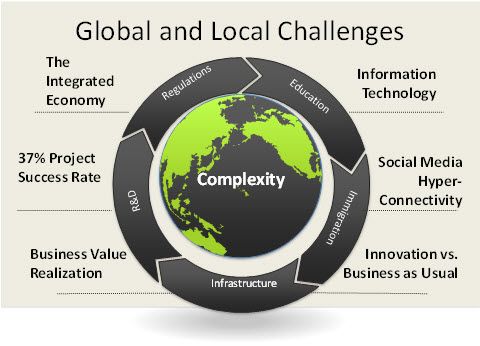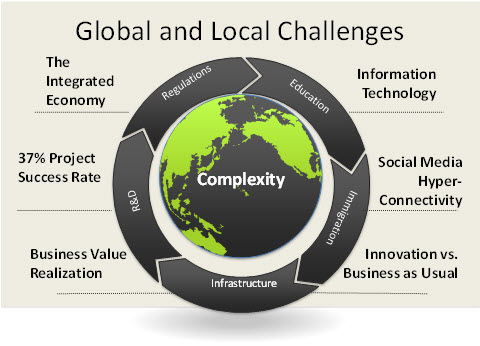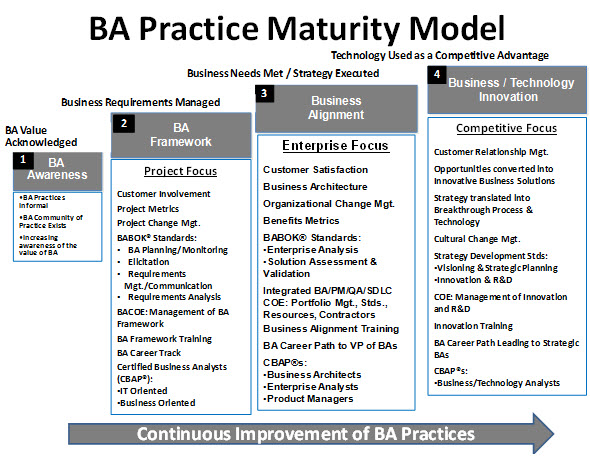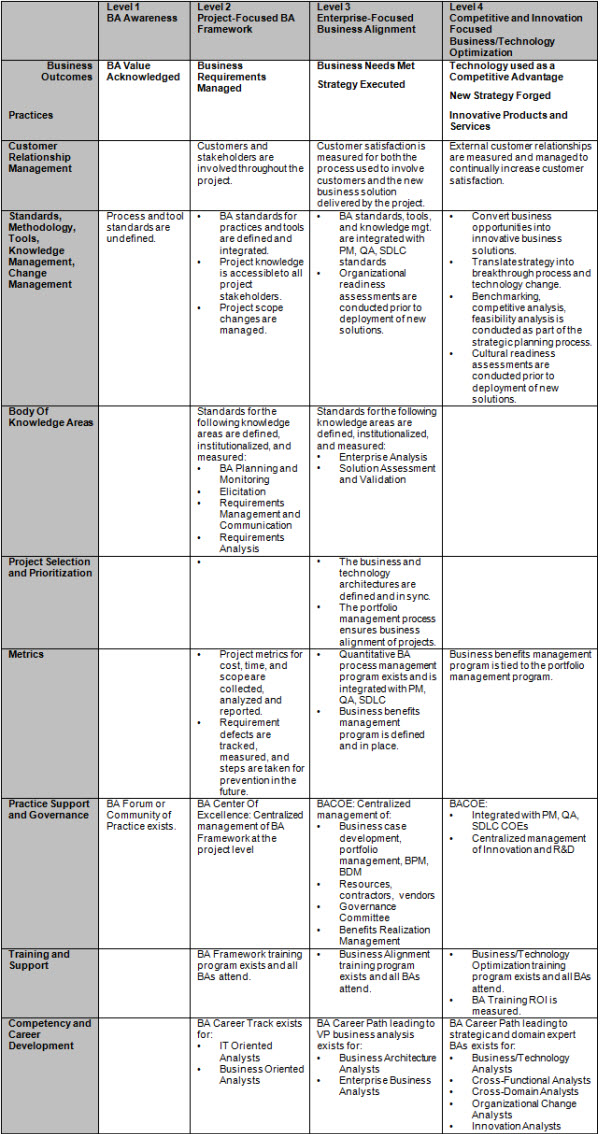The BA Practice Lead Handbook 2 – Why Business Analysis? What’s in it for me?
In the previous article, we discussed the reasons Business Analysis is emerging as a critical business practice for the 21st century. But we sometimes have difficulty explaining the value of Business Analysis; driving an understanding of the WIIFM (What’s in it for me?). So let’s examine what a real BA is, one who is enterprise and strategically focused and who executes strategy, advances enterprise capabilities, and delivers innovative products and services….and what it means for everyone, including:
- What’s in it for the CIO?
- What’s in it for the Business Manager?
- What’s in it for the Technologists?
- What’s in it for the Project Manager?
The Value of the Business Analyst
The most important tool in the Business Analysts’ arsenal is the Business Case. The life of every important change initiative begins and ends with a Business Case. Unless a change initiative (project) results in business benefits in terms of value to the customer and/or wealth to the bottom line, it is a failed venture – even if it is delivered on time and on budget. It is in the Business Case that the expected costs and business benefits are outlined. Without it, you are engaged in steering a rudderless vessel. Yet, in far too many projects, a Business Case does not exist. If it does exist, it is often unconvincing and used only to get funding for a project. The value of the Business Analyst is realized through execution and management of the Business Case, and the role of the BA changes subtly throughout the life of the project.
The Enterprise Analyst. Developing what is often referred to as a “brilliant Business Case” is essentially and R&D, creative endeavor. The effort requires adequate time, a skilled facilitator (the Enterprise BA), a strategic focus, and creative expert resources. The effort is driven by the Business Analyst. The Business Case is owned by the Business Analyst; that is to say the Business Analyst authors and maintains the Business Case in collaboration with business and technology thought leaders.
The Project Analyst. Once a project has been approved based on the Business Case, the Business Analyst transitions from the role of Enterprise Analyst to a Project Analyst. Typically, the Business Case is no longer used, since the project is approved, resourced, and funded. However, as the BA elicits detailed business requirements and the solution design emerges, she continues to validate the expected costs and benefits, updates the Business Case and alerts decision makers if the original assumptions and projections are at risk, and recommends a course correction. This validation/update cycle is essential to keep the Business Case alive, and to keep everyone’s focus on the business benefits. Remember, the Business Case is developed when we know the least about the endeavor, so it is no longer valid unless updated as more is learned.
The Business Realization Analyst. After a new solution is deployed, the BA serves as a Business Realization Manager, measuring the value of the new solution, and making improvements and adjustments to the solution or how it is used if the value does not measure up to the original benefit projections.
Business Analysis: What’s in it for the CIO
Why does a CIO care about Business Analysis? What’s in it for him/her? Consider some insight from the Gartner Group, Northwestern University, and DiamondCluster International survey of 130 senior IT executives:
51% Percentage of CIOs with no process to evaluate IT investment against business strategy
68% Percentage of CIOs who don’t compare actual IT project benefits to original targets
74% Percentage of CIOs who don’t track financial metrics after making an investment
80% Percentage of CIOs who say lack of financial skills makes quantifying IT benefits difficult
This revealing study, together with the fact that only 37% of IT projects are successful, costing the economy billions of dollars (see article #1 in this series), make for a very challenging situation for CIOs. And their peers in the boardroom are increasingly demanding return on their IT investments. CEOs have a stunning awareness that many of their very costly IT projects, whether for technology infrastructure upgrades, to implement a new improved business process, or to deploy a new product or service, fail to achieve expected value. Furthermore, they are frustrated and unclear about how to fix the problem.
If the onslaught of Business Analysis practices promise to produce convincing Business Cases, CIOs can finally predict, deliver, and demonstrate real value. All too often Business Cases relying on traditional ROI measures, are often unrealistically high, knowingly or unknowingly low, or simply unconvincing. BAs need to reverse this trend, producing brilliant Business Cases that are convincing and accurate.
So, here is your elevator speech to your CIO: “Many enlightened CIOs are placing their bets on implementation of a world class Business Analysis Practice to finally predict, produce, deliver, and measure expected business benefits.”
Business Analysis: What’s in it for the Business Manager
One strategy used by executives is to put a mid- to senior-level manager in charge of expensive project investments for a department or line of business. So not only is the CIO being held accountable for driving value to the customer and wealth to the bottom line, front line management is also on the hook.
So, here is your elevator speech to your business partner: “Adequate time spent up front on the business case will ensure we develop an innovative solution, and predict, produce, deliver, and measure expected business benefits.”
Business Analysis: What’s in it for the Technologists?
Similarly, CIOs put a mid- to senior-level IT manager in charge of the technology for expensive IT project investments. So not only is the CIO being held accountable for driving value to the customer and wealth to the bottom line, front line IT management is also on the hook.
Assuming the BA partners with the business manager and lead technologist who are on point when creating the Business Case, they will be invaluable in helping keep the focus on the business benefits.
So, here is your elevator speech to your lead technologist: “An experienced BA assigned throughout the project will ensure we develop an innovative solution, and predict, produce, deliver, and measure expected business benefits.”
Business Analysis: What’s in it for the Project Manager
And then there is the project manager (PM). Whether there is a convincing Business Case or not, the PM is expected to drive forward, delivering the solution on time and on budget. The PM cares about cost, but only project cost as opposed to the total cost of ownership of the new solution. PMs generally don’t focus on the cost to operate or maintain the new solution, only on the build or acquisition costs. As a result, project success to PMSs is often determined by measures other than business value.
The BA keeps the focus on the business value expected from the new solution. The BA collaborates with the PM to conduct trade-off analysis and make the tough project decisions. The BA also had her ear to the ground to determine if business needs are changing that might impact the current project objectives.
So, here is your elevator speech to your PM: “It has been estimated that a PM increases the probability of project success by 400% with an exceptional BA on the project.” (BA Benchmark Study, AG Consulting 2008)
Putting it all Together
So what does this mean for the Business Analyst?
If your project does not have a Business Case, pull together a small but mighty team of experts and facilitate them through the development of key Business Case elements. You will need experts who can predict trends, think outside the box, see the big picture, deal with complexity, and help create a strong team. Then, present the Business Case to the business executive and lead technologist who have the most ownership in the success of the project, and ask them if it describes what they are looking for from the project outcomes.
What’s in it for the BA? This will get you noticed as an elite BA, one who is focusing on business value as opposed to requirements management. Look for more about building a convincing Business Case in future articles in this series.
So what does this mean for the BA Practice Lead?
As Practice Lead/BA Manager, your primary focus should be on the capability of your BA team to build brilliant Business Cases. Develop a standard agenda for conducting a Business Case workshop. Insist that your BAs build and maintain Business Cases for all critical projects.
Don’t forget to leave your comments below.





 The Quiet. The Unknown. The Courageous
The Quiet. The Unknown. The Courageous